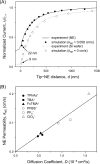Ion permeability of the nuclear pore complex and ion-induced macromolecular permeation as studied by scanning electrochemical and fluorescence microscopy
- PMID: 24460147
- PMCID: PMC3955255
- DOI: 10.1021/ac403607s
Ion permeability of the nuclear pore complex and ion-induced macromolecular permeation as studied by scanning electrochemical and fluorescence microscopy
Abstract
Efficient delivery of therapeutic macromolecules and nanomaterials into the nucleus is imperative for gene therapy and nanomedicine. Nucleocytoplasmic molecular transport, however, is tightly regulated by the nuclear pore complex (NPC) with the hydrophobic transport barriers based on phenylalanine and glycine repeats. Herein, we apply scanning electrochemical microscopy (SECM) to quantitatively study the permeability of the NPCs to small probe ions with a wide range of hydrophobicity as a measure of their hydrophobic interactions with the transport barriers. Amperometric detection of the redox-inactive probe ions is enabled by using the ion-selective SECM tips based on the micropipet- or nanopipet-supported interfaces between two immiscible electrolyte solutions. The remarkably high ion permeability of the NPCs is successfully measured by SECM and theoretically analyzed. This analysis demonstrates that the ion permeability of the NPCs is determined by the dimensions and density of the nanopores without a significant effect of the transport barriers on the transported ions. Importantly, the weak ion-barrier interactions become significant at sufficiently high concentrations of extremely hydrophobic ions, i.e., tetraphenylarsonium and perfluorobutylsulfonate, to permeabilize the NPCs to naturally impermeable macromolecules. Dependence of ion-induced permeabilization of the NPC on the pathway and mode of macromolecular transport is studied by using fluorescence microscopy to obtain deeper insights into the gating mechanism of the NPC as the basis of a new transport model.
Figures







Similar articles
-
Nanoscale Hydrophobicity of Transport Barriers in the Nuclear Pore Complex as Compared with the Liquid/Liquid Interface by Scanning Electrochemical Microscopy.Anal Chem. 2025 Feb 11;97(5):2745-2753. doi: 10.1021/acs.analchem.4c04861. Epub 2025 Jan 29. Anal Chem. 2025. PMID: 39878353 Free PMC article.
-
Nanoscale Quantitative Imaging of Single Nuclear Pore Complexes by Scanning Electrochemical Microscopy.Anal Chem. 2024 Jul 2;96(26):10765-10771. doi: 10.1021/acs.analchem.4c01890. Epub 2024 Jun 21. Anal Chem. 2024. PMID: 38904303 Free PMC article.
-
Probing High Permeability of Nuclear Pore Complexes by Scanning Electrochemical Microscopy: Ca2+ Effects on Transport Barriers.Anal Chem. 2019 Apr 16;91(8):5446-5454. doi: 10.1021/acs.analchem.9b00796. Epub 2019 Apr 3. Anal Chem. 2019. PMID: 30907572 Free PMC article.
-
Calcium regulation of nucleocytoplasmic transport.Protein Cell. 2011 Apr;2(4):291-302. doi: 10.1007/s13238-011-1038-x. Epub 2011 Apr 27. Protein Cell. 2011. PMID: 21528351 Free PMC article. Review.
-
The selective permeability barrier in the nuclear pore complex.Nucleus. 2016 Sep 2;7(5):430-446. doi: 10.1080/19491034.2016.1238997. Epub 2016 Sep 27. Nucleus. 2016. PMID: 27673359 Free PMC article. Review.
Cited by
-
Nanoscale interactions of arginine-containing dipeptide repeats with nuclear pore complexes as measured by transient scanning electrochemical microscopy.Chem Sci. 2024 Aug 30;15(38):15639-46. doi: 10.1039/d4sc05063k. Online ahead of print. Chem Sci. 2024. PMID: 39246336 Free PMC article.
-
GABA Detection with Nano-ITIES Pipet Electrode: A New Mechanism, Water/DCE-Octanoic Acid Interface.Anal Chem. 2018 Mar 6;90(5):3067-3072. doi: 10.1021/acs.analchem.7b03099. Epub 2018 Feb 15. Anal Chem. 2018. PMID: 29388419 Free PMC article.
-
Nanoscale Hydrophobicity of Transport Barriers in the Nuclear Pore Complex as Compared with the Liquid/Liquid Interface by Scanning Electrochemical Microscopy.Anal Chem. 2025 Feb 11;97(5):2745-2753. doi: 10.1021/acs.analchem.4c04861. Epub 2025 Jan 29. Anal Chem. 2025. PMID: 39878353 Free PMC article.
-
Nanoscale electrostatic gating of molecular transport through nuclear pore complexes as probed by scanning electrochemical microscopy.Chem Sci. 2019 Jul 8;10(34):7929-7936. doi: 10.1039/c9sc02356a. eCollection 2019 Sep 14. Chem Sci. 2019. PMID: 31673318 Free PMC article.
-
Correlating Live Cell Viability with Membrane Permeability Disruption Induced by Trivalent Chromium.ACS Omega. 2019 Jan 31;4(1):2142-2151. doi: 10.1021/acsomega.8b02113. Epub 2019 Jan 28. ACS Omega. 2019. PMID: 30775648 Free PMC article.
References
-
- Terry L. J.; Shows E. B.; Wente S. R. Science 2007, 318, 1412. - PubMed
-
- Strambio-De-Castillia C.; Niepel M.; Rout M. P. Nat. Rev. Mol. Cell Biol. 2010, 11, 490. - PubMed
-
- Pack D. W.; Hoffman A. S.; Pun S.; Stayton P. S. Nat. Rev. Drug Discovery 2005, 4, 581. - PubMed
-
- Raices M.; D’Angelo M. A. Nat. Rev. Mol. Cell Biol. 2012, 13, 687. - PubMed
-
- Frenkiel-Krispin D.; Maco B.; Aebi U.; Medalia O. J. Mol. Biol. 2010, 395, 578. - PubMed
Publication types
MeSH terms
Substances
Grants and funding
LinkOut - more resources
Full Text Sources
Other Literature Sources

